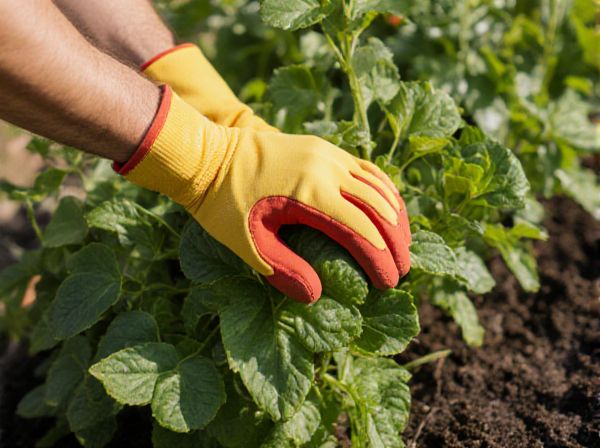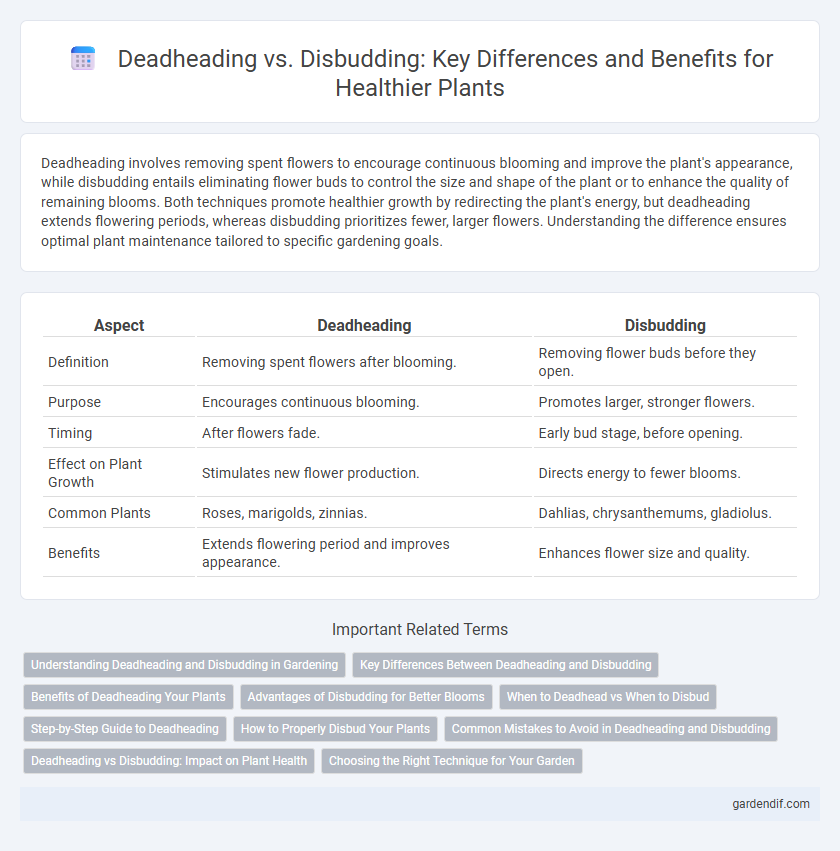
Deadheading vs Disbudding Illustration
Deadheading involves removing spent flowers to encourage continuous blooming and improve the plant's appearance, while disbudding entails eliminating flower buds to control the size and shape of the plant or to enhance the quality of remaining blooms. Both techniques promote healthier growth by redirecting the plant's energy, but deadheading extends flowering periods, whereas disbudding prioritizes fewer, larger flowers. Understanding the difference ensures optimal plant maintenance tailored to specific gardening goals.
Table of Comparison
| Aspect | Deadheading | Disbudding |
|---|---|---|
| Definition | Removing spent flowers after blooming. | Removing flower buds before they open. |
| Purpose | Encourages continuous blooming. | Promotes larger, stronger flowers. |
| Timing | After flowers fade. | Early bud stage, before opening. |
| Effect on Plant Growth | Stimulates new flower production. | Directs energy to fewer blooms. |
| Common Plants | Roses, marigolds, zinnias. | Dahlias, chrysanthemums, gladiolus. |
| Benefits | Extends flowering period and improves appearance. | Enhances flower size and quality. |
Understanding Deadheading and Disbudding in Gardening
Deadheading involves removing spent flowers to encourage new blooms, enhancing plant vitality and extending the flowering period. Disbudding is the selective removal of buds to direct the plant's energy toward fewer, larger flowers, improving their size and quality. Both techniques optimize plant growth and aesthetic appeal by manipulating flower production effectively.
Key Differences Between Deadheading and Disbudding
Deadheading involves removing spent flowers to encourage further blooming and maintain the plant's appearance, while disbudding refers to the removal of buds to control plant size or improve flower quality. Deadheading targets faded blossoms, promoting extended flowering periods, whereas disbudding eliminates undesirable or excess buds early in development. The primary goal of deadheading is enhancing aesthetics and prolonging bloom, whereas disbudding focuses on optimizing flower size and plant structure.
Benefits of Deadheading Your Plants
Deadheading your plants promotes continuous blooming by removing faded flowers, which diverts the plant's energy back into growth and new flower production. This practice reduces the risk of disease by eliminating decaying flower parts that attract pests and pathogens. Regular deadheading also improves the overall appearance of plants, keeping gardens tidy and visually appealing.
Advantages of Disbudding for Better Blooms
Disbudding promotes stronger, more vibrant blooms by directing the plant's energy towards fewer, healthier flowers instead of many smaller buds. This technique enhances flower size, quality, and overall aesthetic appeal, making it ideal for competitive gardening and floral arrangement. By reducing overcrowding, disbudding also improves air circulation, which decreases the risk of disease and supports plant health.
When to Deadhead vs When to Disbud
Deadheading is ideal after flower blooms begin to fade, typically throughout the growing season, to encourage continuous blooming and extend the plant's flowering period. Disbudding should be done early in the bud stage before flowers open, especially in plants like dahlias and roses, to promote larger, more vigorous blooms by removing extra buds. Timing deadheading after blossoms wilt maximizes plant energy efficiency, while prompt disbudding focuses resources on selected buds for optimal bloom quality.
Step-by-Step Guide to Deadheading
Deadheading involves removing spent flowers from plants to encourage continuous blooming and improve appearance by cutting just above the first set of healthy leaves or buds. This process helps redirect the plant's energy from seed production to growth and flower development. Regular deadheading, especially in annuals and perennials like roses and petunias, promotes a longer flowering season and healthier plants.
How to Properly Disbud Your Plants
To properly disbud your plants, identify and carefully remove the smaller, undeveloped flower buds early in the growing season using clean, sharp pruning shears or your fingers. This technique directs the plant's energy toward developing larger, healthier blooms by reducing overcrowding and improving air circulation. Regular monitoring and timely disbudding promote optimal flowering and minimize disease risk in plants like roses, dahlias, and chrysanthemums.
Common Mistakes to Avoid in Deadheading and Disbudding
Common mistakes to avoid in deadheading include cutting too close to the new growth, which can damage stems and reduce flowering, and failing to remove all spent blooms, allowing the plant to expend energy on seed production instead of new blossoms. In disbudding, errors such as removing buds too early or too late can stunt plant growth or reduce flower size and quality, while improper tool sanitation can introduce diseases. Maintaining precise timing and proper technique enhances plant health and encourages more abundant, vibrant blooms.
Deadheading vs Disbudding: Impact on Plant Health
Deadheading involves removing spent flowers to encourage further blooming and prevent disease by reducing decaying organic matter on plants. Disbudding focuses on removing early flower buds to direct the plant's energy towards fewer, stronger blooms, enhancing overall plant vigor. Both techniques improve plant health by managing energy allocation and reducing potential infection sites, but deadheading promotes continuous flowering while disbudding optimizes flower quality.
Choosing the Right Technique for Your Garden
Deadheading removes spent flowers to encourage continuous blooming and improve garden aesthetics, while disbudding involves removing flower buds to promote larger, healthier blooms. Selecting the right technique depends on your garden goals: deadheading is ideal for extending flowering periods in annuals and perennials, whereas disbudding is preferred for hybrid tea roses and dahlias aiming for quality over quantity. Understanding your plant species and desired results ensures effective management of growth and visual appeal.
Deadheading vs Disbudding Infographic

 gardendif.com
gardendif.com